Shipping is one of the most crucial — yet often overlooked — elements of running a successful eCommerce business.
You’ve created a stunning website, filled it with products your customers love, and attracted a steady flow of buyers. But when it’s time to get those products from your warehouse to your customers’ doorsteps, that’s where shipping comes in.
Managing eCommerce shipping requires more than selecting a carrier or printing labels. It involves understanding different shipping methods, choosing the right software, and setting clear policies.
So, if you have an eCommerce business and want to set up the shipping policy, you are in the right place. Today, we will discuss anything and everything about eCommerce shipping.
So, keep reading this guide to unveil everything!
What is eCommerce Shipping?
eCommerce shipping is the process of delivering products from an online store to a customer’s location. It covers everything from packing the item to sending it through a shipping carrier and making sure it reaches the buyer safely.
This process includes managing shipping options, handling logistics, and tracking deliveries. The goal is to make sure customers get their orders on time and in good condition. Without reliable shipping, even the best products can lead to unhappy customers.
For example, if you run an online business and someone places an order, you need to deliver the product to their address. The whole process from receiving the order to delivering the product is known as eCommerce shipping.
Why Shipping is Important for an eCommerce Business
Shipping is a crucial part of any eCommerce business because it connects the purchase with the customer. When customers receive their orders on time and in good condition, it builds trust and encourages them to shop with you again.
Here are a few more reasons why you should take shipping very carefully:
- Builds Customer Trust: Reliable and timely deliveries show customers that your business is dependable. When customers know they’ll get their orders on time, they’re more likely to trust and return to your store.
- Enhances Customer Experience: Smooth shipping with options like express delivery or free shipping improves the shopping experience. It keeps customers happy and encourages them to shop with you again.
- Expands Customer Reach: Offering flexible shipping options, like international shipping or various carrier choices, allows you to reach a wider audience. This flexibility can attract customers who value convenience.
- Boosts Brand Loyalty: Positive delivery experiences create a strong impression. When customers are satisfied with your service, they’re more likely to become repeat buyers and recommend your brand.
- Reduces Cart Abandonment: Clear, affordable shipping options can help reduce cart abandonment. Customers are more likely to complete their purchase if they see reasonable and transparent shipping costs.
We hope, now you know why shipping is important for any eCommerce business.
eCommerce Shipping Process Explained
The eCommerce shipping process covers everything from when an order is placed to when it reaches the customer. And even what happens if the product is returned.
Each stage is crucial to ensuring a smooth experience for the customer and can greatly impact their view of your brand.
Let’s break down each step with a closer look!
I. Order Receiving
Order receiving is when an eCommerce business gets the order through its online store. Once a customer places an order, the system automatically generates an order confirmation and sends it to the business.
For example, if a customer buys a pair of shoes, the business is notified instantly, and the order status may be updated to “Processing” in the customer’s account. This stage is important because confirming the order right away reassures the customer and lets them know their purchase is in progress.
II. Order Processing
Order processing is the stage where the business prepares the order for shipment. This includes checking stock, picking the item, and packing it securely.
For the shoe order, this would mean locating the right size and style in inventory, carefully packaging the shoes, and adding necessary labels for shipping. Mistakes at this stage can lead to unhappy customers, so accuracy and speed are key.
III. Order Fulfillment
Order fulfillment is when the order is handed off to a shipping carrier and starts its journey to the customer. After the package is prepared, the business partners with a carrier, such as UPS or FedEx, to send it out for delivery.
After the shoes are packed and labeled, the business hands them off to a carrier, like FedEx or UPS, which begins the delivery process. If the customer selected express shipping, the order might be prioritized for faster delivery. Customers often receive a tracking link at this stage, which lets them follow the shoes’ journey in real time.
IV. Manage Returning
Order returning is the process of handling product returns when a customer decides to send an item back. This might happen if the product doesn’t fit or meets the customer’s expectations.
For instance, if the shoes don’t fit or weren’t as expected, the customer can initiate a return, often using a prepaid label provided by the business. An easy return process, like allowing the customer to print a label and drop the package off at a nearby carrier location, helps build trust.
Check this image to understand how eCommerce shipping works!
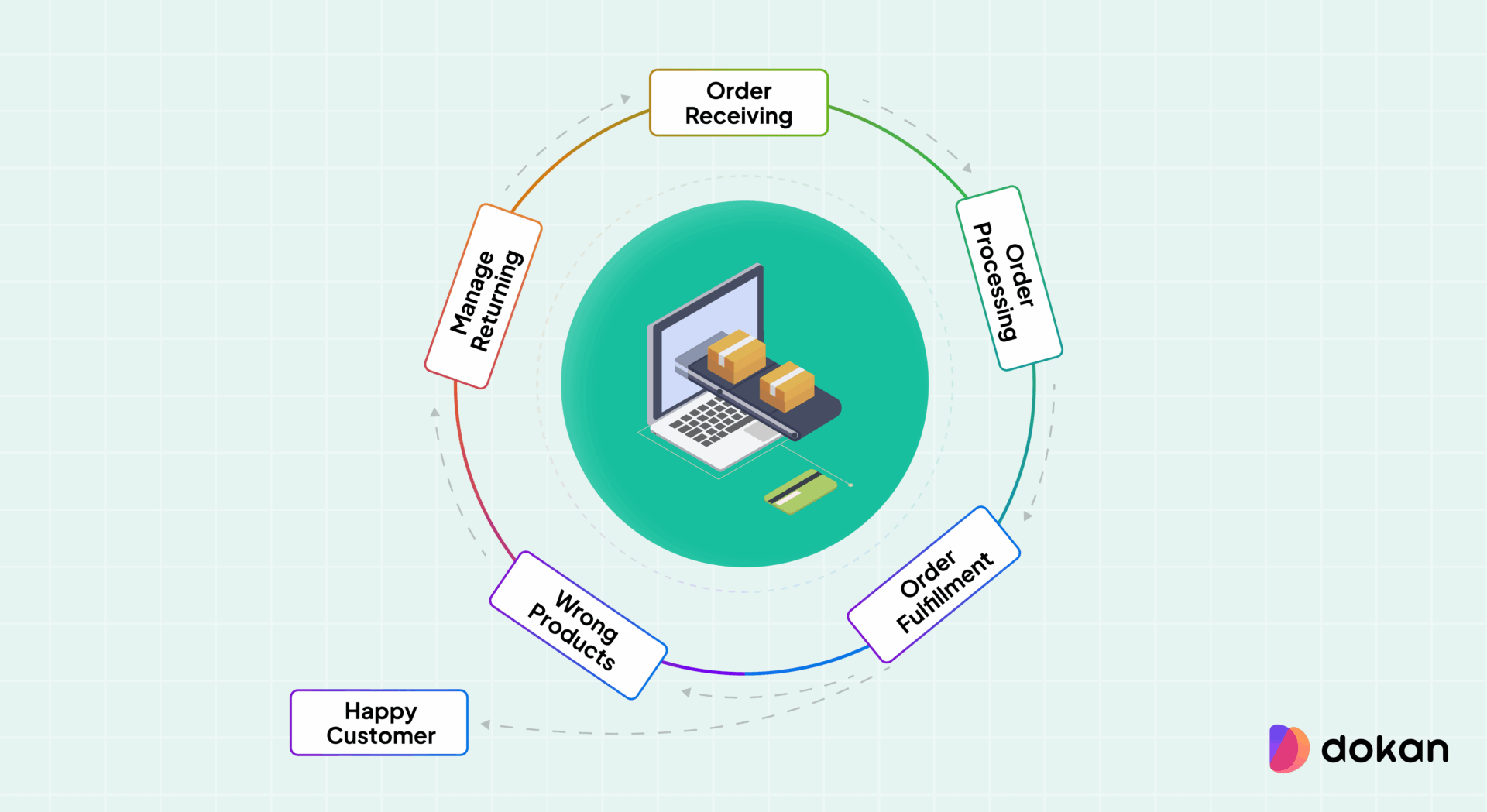
eCommerce Shipping Methods
Choosing the right shipping method is crucial for any eCommerce business. The shipping method you offer can affect delivery speed, cost, and customer satisfaction.
Let’s go over the most common shipping methods used by online businesses:
- Standard Shipping
- Expedited Shipping
- Same-Day and Next-Day Shipping
- International Shipping
- Hybrid Shipping
Now let’s get into the details!
i) Standard Shipping
Standard shipping is the most basic and cost-effective shipping method. It usually takes longer for delivery compared to other methods. Depending on the destination, it can take 3 to 7 business days to deliver the product.
If a customer orders a pair of shoes and chooses standard shipping, the delivery may take several days to arrive. Standard shipping is ideal for customers who don’t need their order immediately and are looking for an affordable option.
ii) Expedited Shipping
Expedited shipping is faster than standard shipping. Typically it takes 2 to 3 business days to deliver the product. This method allows customers to receive their orders more quickly without paying for the speed of same-day or next-day delivery.
If a customer orders shoes using expedited shipping, they can expect the delivery in a shorter time frame, usually at an extra cost. This method is a great option for customers who need their products sooner but don’t require same-day or next-day delivery.
iii) Same-Day and Next-Day Shipping
Same-day and next-day shipping are the fastest methods available. As the names suggest, same-day shipping delivers orders on the same day they are placed (if the order is made within a specific time window), while next-day shipping ensures delivery by the next business day.
For example, if a customer orders shoes in the morning, they can receive them by evening with same-day shipping or the next day with next-day shipping. These methods are more expensive but are perfect for customers who need their products urgently.
iv) International Shipping
International shipping is used when delivering orders to customers outside the country. This method takes longer than domestic shipping. Depending on the customer’s destination, it can take a few days to a couple of weeks to deliver the product.
Suppose you are a customer and you want to order a pair of shoes from a US-based store and live in the UK. In this scenario, international shipping will be used. International shipping can be more expensive due to customs fees and longer delivery times but allows businesses to reach customers around the globe.
v) Hybrid Shipping
Hybrid shipping combines multiple shipping services, often mixing local and international carriers. For example, a business might use a local carrier for the first leg of the journey (like ground transportation) and then hand off the package to a global carrier for international delivery.
Hybrid shipping can offer lower costs and more flexible options for businesses, while still ensuring timely deliveries. For instance, a shoe order placed in the US might be shipped via hybrid shipping, where the local carrier handles the domestic part of the journey, and an international carrier takes care of delivery overseas.
Shipping Method Comparison Table
| Shipping Method | Delivery Speed | Cost | Best For |
|---|---|---|---|
| Standard Shipping | Slowest | Lowest | Non-urgent orders, budget-conscious customers |
| Expedited Shipping | Faster than standard | Higher than standard | Customers needing items quickly but not immediately |
| Same-Day/Next-Day Shipping | Fastest | Highest | Urgent orders, last-minute gifts, immediate needs |
| International Shipping | Varies by destination | Varies by destination, weight, and customs | Shipping goods to another country |
| Hybrid Shipping | Varies depending on the combination | Varies depending on the combination | Specific scenarios needing a balance of speed and cost |
eCommerce Shipping Carrier Options
To be very honest with you, there are many shipping carriers around you. However, you should choose a shipping carrier that fits your needs and budget. The right carrier can impact not only your shipping efficiency but also the overall customer experience.
We’ve researched, analyzed, and compiled a list of the 5 best eCommerce shipping carriers for you. Here is the list:
- United States Postal Service (USPS)
- UPS (United Parcel Service)
- FedEx
- Third-Party Logistics (3PL) Providers
- DHL
Now let’s jump into the deep to find out which shipping carrier would be a good choice for you!
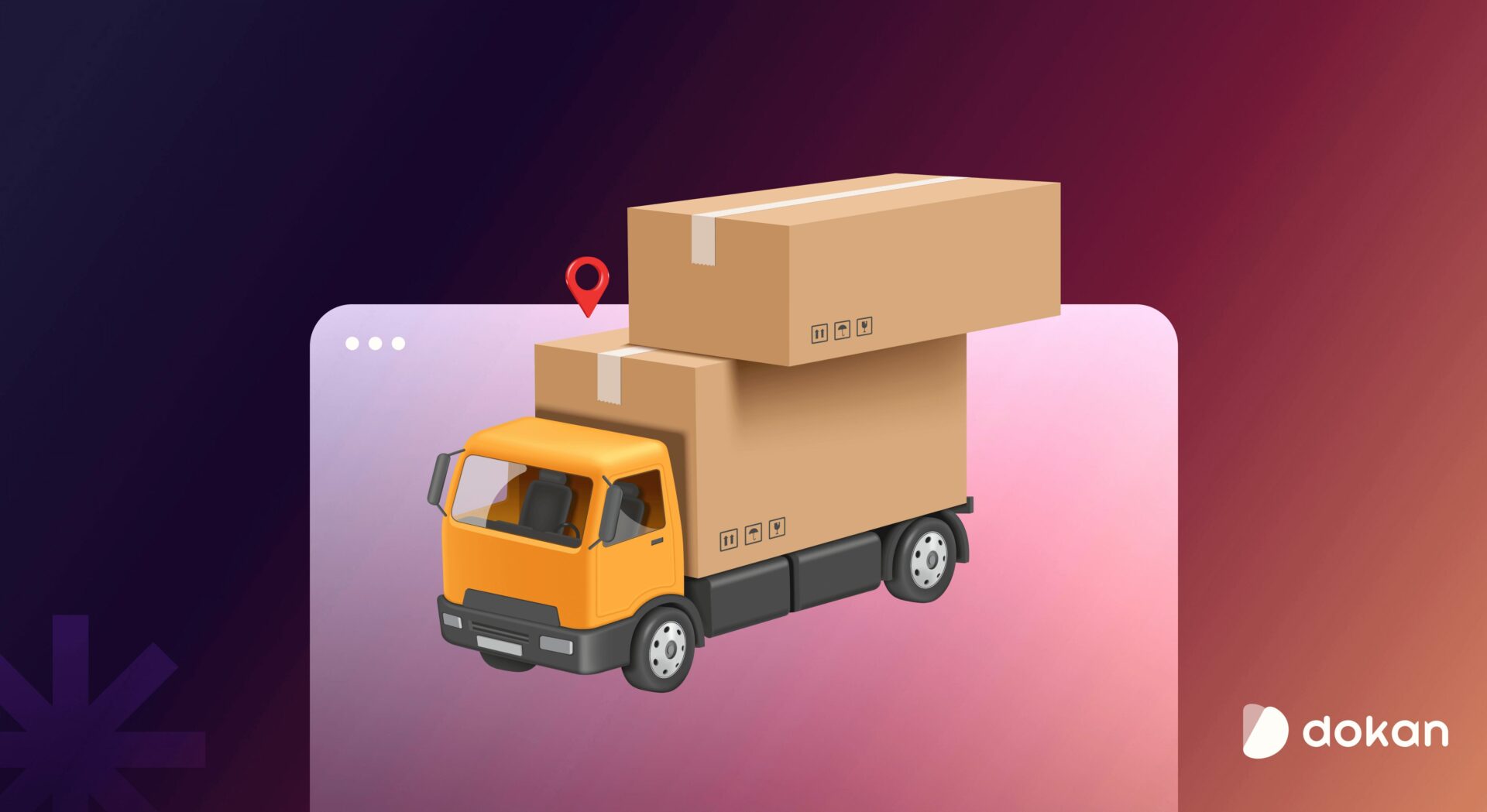
a) United States Postal Service (USPS)
USPS is a popular carrier, especially for smaller packages and domestic deliveries in the United States. It is known for its affordable shipping rates and extensive delivery network.
USPS reaches every address in the U.S., even in remote locations. For example, USPS’s First-Class and Priority Mail options are commonly used for lightweight items which makes them ideal for eCommerce businesses looking to minimize costs.
b) UPS (United Parcel Service)
UPS is known for its reliability and range of shipping options, including expedited services. It is particularly popular for heavier packages and provides efficient tracking and insurance options.
For instance, UPS Ground is a cost-effective solution for businesses shipping domestically, while UPS Next Day Air offers fast delivery for urgent orders. UPS’s extensive logistics network also makes it a good choice for businesses shipping large volumes.
c) FedEx
FedEx is a top choice for eCommerce businesses that need fast and reliable shipping, especially for international deliveries. Known for its express options, FedEx provides services like FedEx Express for next-day delivery and FedEx International for fast global shipping.
eCommerce businesses often choose FedEx when they need guaranteed delivery times, as FedEx is known for its punctuality and tracking capabilities.
d) Third-Party Logistics (3PL) Providers
3PL providers offer outsourced logistics solutions, handling not only shipping but also warehousing, packaging, and returns. This option is popular for growing eCommerce businesses that need support with fulfillment.
A 3PL partner can manage inventory storage, pick and pack orders, and coordinate with various carriers for delivery. For example, an eCommerce business could partner with a 3PL to store and ship its products which allows it to focus more on sales and customer service.
e) DHL
DHL is a global logistics carrier known for its efficient international shipping services. It operates in over 220 countries which makes it a strong choice for businesses with a large international customer base.
DHL Express is popular for fast global delivery, while other DHL options provide economical international shipping for less time-sensitive items. With its global reach and focus on international logistics, DHL is ideal for eCommerce businesses aiming to expand their global footprint.
What Are the Costs Associated with eCommerce Shipping
eCommerce shipping involves various costs that you need to consider to ensure efficient and budget-friendly delivery. Here are the main costs associated with eCommerce shipping:
- Shipping Costs
- Packaging Costs
- Fulfillment Costs
- Insurance Costs
- Returns Processing Costs
- Duties and Taxes (for International Shipping)
Now let us explain each cost associated with eCommerce shipping to you!
I. Shipping Costs
Shipping costs are the direct charges associated with transporting an order from the business to the customer. These costs depend on factors like package weight, dimensions, shipping distance, and delivery speed.
II. Packaging Costs
Packaging costs include the expenses for materials used to pack and protect products, such as boxes, bubble wrap, and tape. These costs can vary based on the size and fragility of the item. For example, fragile items like glassware require extra protective packaging, which increases the overall cost.
III. Fulfillment Costs
Fulfillment costs are expenses involved in preparing and processing orders for shipment. This includes costs for labor, order picking, packing, and warehousing (if applicable). For businesses handling fulfillment in-house, these costs cover employee wages and warehouse operations.
IV. Insurance Costs
Insurance costs refer to the expense of insuring packages during transit to provide protection in case of loss, damage, or theft. For high-value items, insurance is often essential to safeguard against potential risks. For instance, an eCommerce business shipping electronics or luxury goods may opt to insure packages to cover the replacement cost if something goes wrong.
V. Returns Processing Costs
Returns processing costs are the expenses related to managing product returns and refunds. This includes costs for return shipping, inspecting returned items, and restocking. If a business offers free returns, these costs can add up, especially if the return rate is high.
VI. Duties and Taxes (for International Shipping)
Duties and taxes are additional fees for international orders to cover customs charges that vary by country. These fees are often paid by the customer, but some businesses choose to cover them to offer a smoother shopping experience.
eCommerce Shipping Rate Options
Shipping rates are an important part of an eCommerce strategy, as they can influence purchasing decisions and impact customer satisfaction. As an eCommerce business owner, you should be aware of these shipping rate options:
- Flat Rate Shipping
- Free Shipping
- Real-Time Carrier Rates
- Tiered Shipping
- Table Rate Shipping
Now we’ll discuss each of the above-mentioned points in detail!
i) Flat Rate Shipping
Flat rate shipping offers a consistent shipping fee for all orders or specific categories of products, regardless of the size, weight, or distance. For instance, an online clothing store might charge a flat rate of $5 for every order within the U.S.
ii) Free Shipping
Free shipping is a popular option to attract customers, as it removes the additional cost of delivery at checkout. Businesses can offer free shipping on all orders or set conditions, such as a minimum order amount (e.g., free shipping on orders over $50).
While this option absorbs the shipping costs for the business, it can boost sales and reduce cart abandonment rates, as customers are more likely to complete a purchase when shipping is free.
iii) Real-Time Carrier Rates
Real-time carrier rates allow businesses to offer customers live shipping rates based on carrier fees at checkout. These rates consider factors like package weight, dimensions, destination, and delivery speed, pulling current pricing directly from carriers like UPS or FedEx.
For example, if a customer is ordering shoes, they’ll see the exact shipping cost for standard, expedited, or express options based on real-time data.
iv) Tiered Shipping
Tiered shipping sets different shipping rates based on the order’s total value or weight. For instance, a business might offer $5 shipping for orders under $50, $3 shipping for orders between $50-$100, and free shipping for orders over $100. Tiered shipping can encourage customers to reach higher order values. It benefits both the customer and the business.
v) Table Rate Shipping
Table rate shipping allows for a customized approach to shipping costs based on multiple variables, such as order total, weight, destination, and delivery method.
This option is ideal for businesses with diverse product sizes and destinations, as they can create detailed rules to determine shipping rates. For example, a business might set a rule where local orders under 10 lbs. are charged $4, while heavier or international orders have higher fees.
Table rate shipping offers the flexibility to optimize costs and provide fair rates across different customer segments.
Top eCommerce Shipping Software
To streamline the shipping process, many eCommerce businesses turn to shipping software solutions that help manage orders, track packages, and optimize costs. If you want to choose an eCommerce shipping software for your business, you should check out these options:
- ShipStation
- Easyship
- ShippingEasy
- ShipBob
- ShipHero
Let’s jump into the details!
a) ShipStation
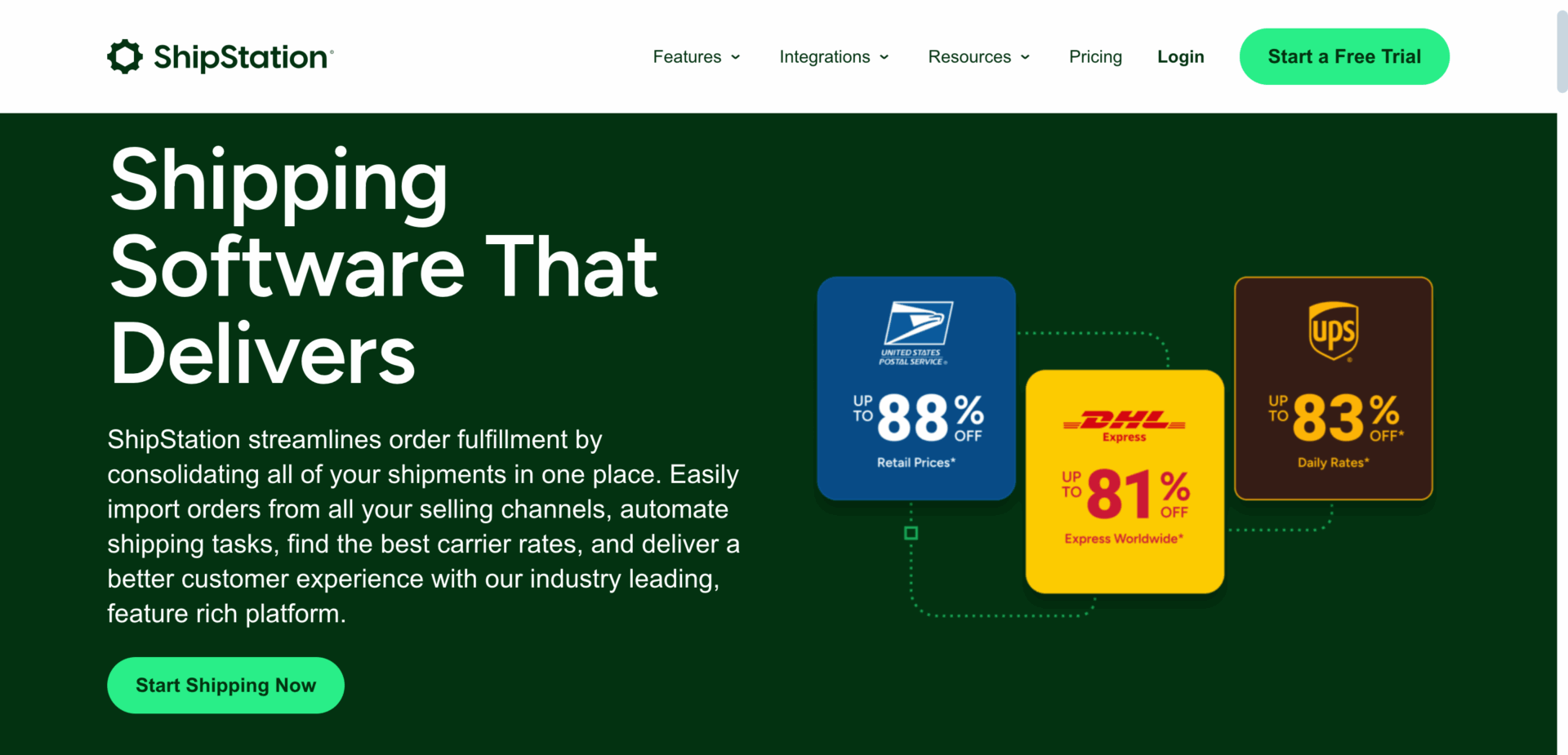
ShipStation is a popular choice for eCommerce businesses looking to automate and manage their shipping operations efficiently. It integrates with major eCommerce platforms and carriers to allow you to import orders, print shipping labels, and track shipments all in one place.
b) Easyship
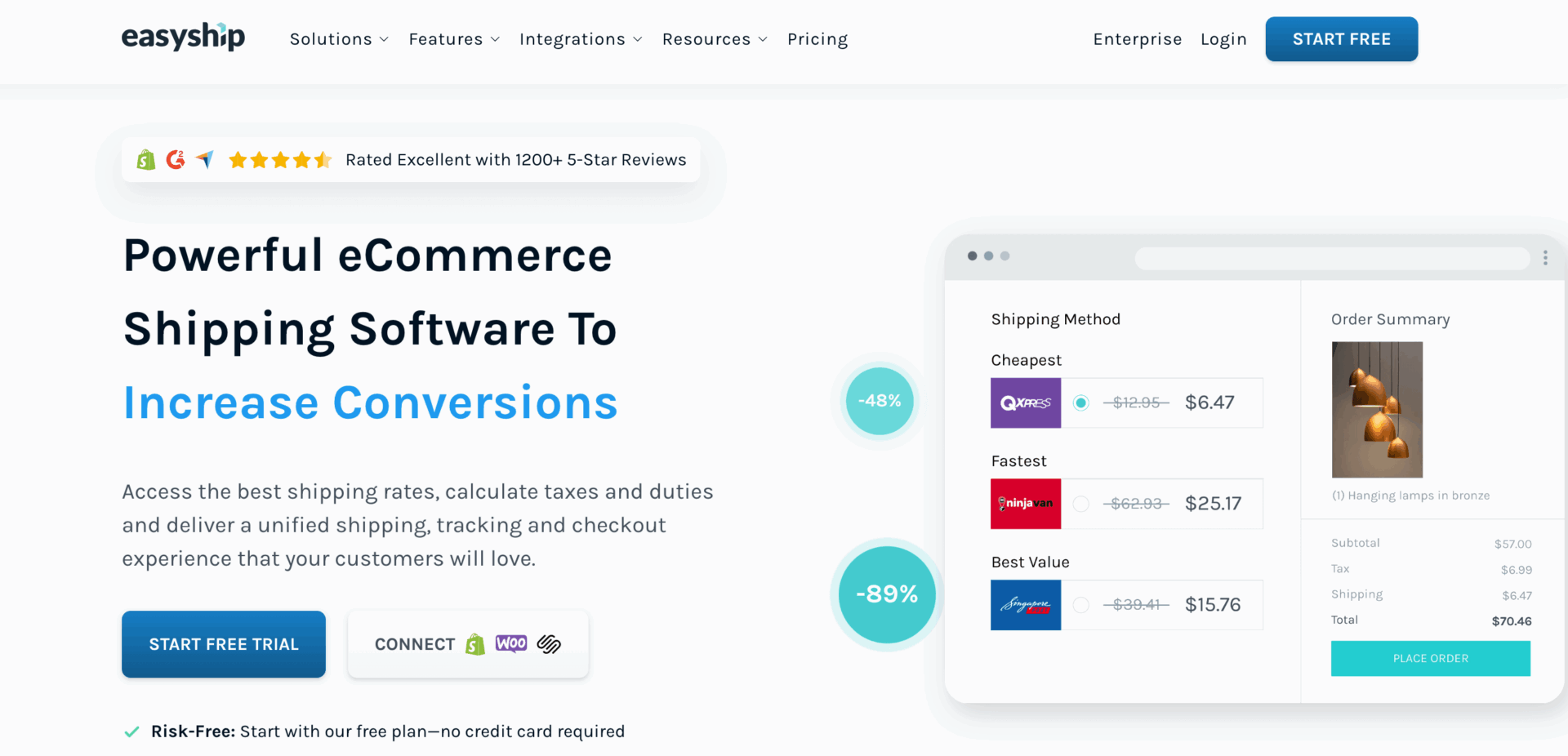
Easyship is known for its flexibility in handling international shipping. It offers real-time shipping rates, tax and duty calculations, and discounted rates from over 250 global shipping carriers. This makes it an ideal choice for businesses with an international customer base.
c) ShippingEasy
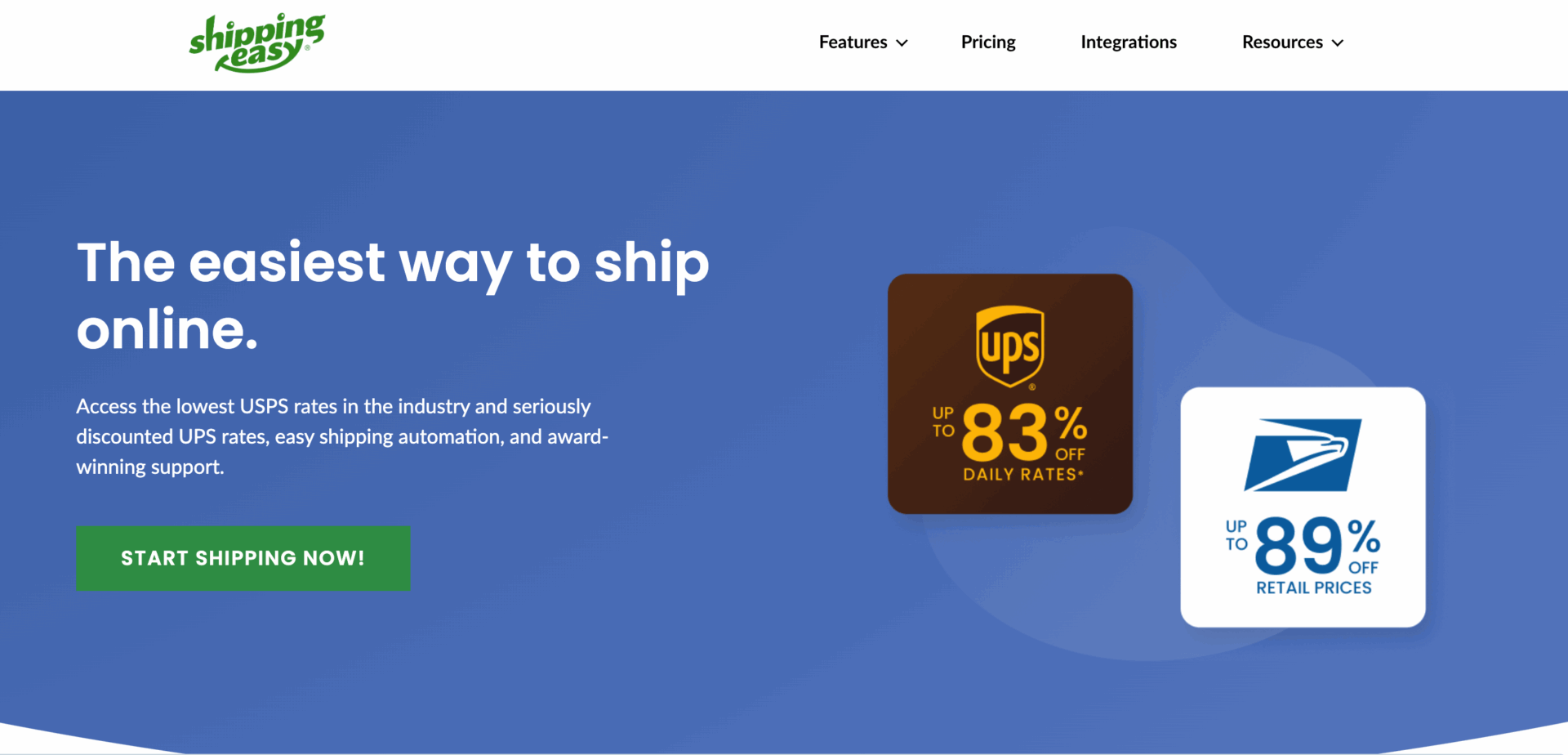
ShippingEasy combines order management and shipping automation with customer marketing tools. It integrates with major eCommerce platforms and offers discounted USPS shipping rates which makes it ideal for small to medium-sized businesses. This can be especially useful for businesses that want to streamline both order fulfillment and customer retention.
d) ShipBob
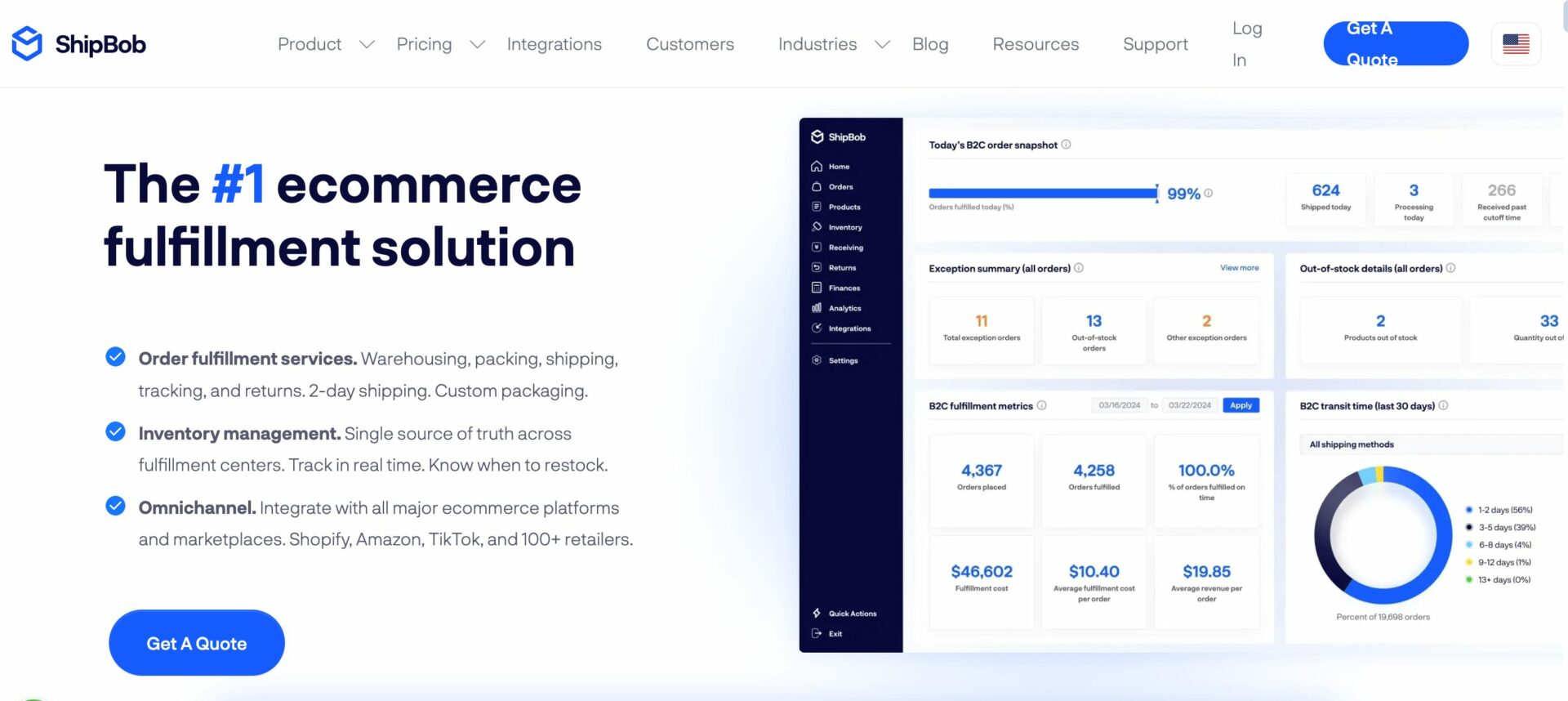
ShipBob is a full-service logistics provider that handles warehousing, order fulfillment, and shipping. Designed for scaling eCommerce businesses, ShipBob provides storage facilities across multiple locations to ensure fast and cost-effective deliveries.
e) ShipHero
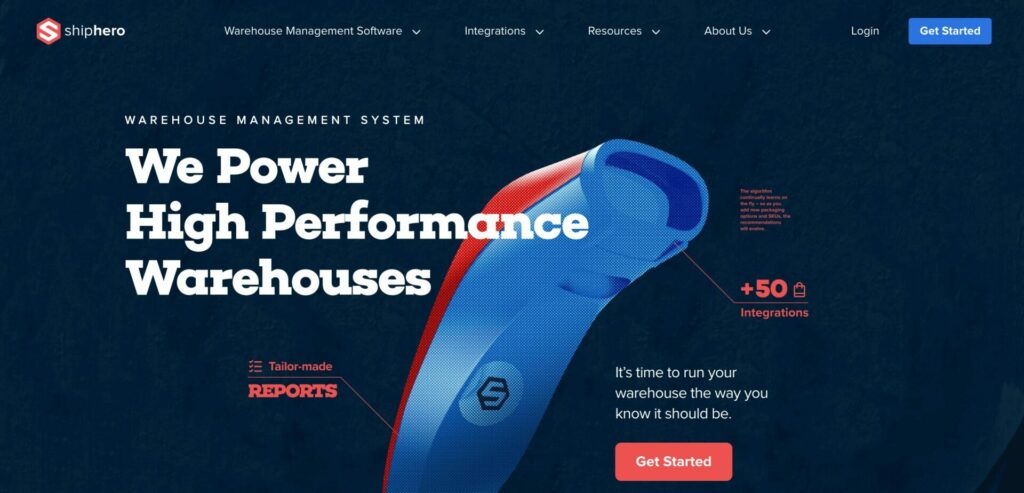
ShipHero is a versatile solution for businesses seeking to manage their entire fulfillment process. It offers software for in-house fulfillment as well as third-party logistics (3PL) services to give you the option to either manage your own warehouse or let ShipHero handle it. Its software includes inventory management, order processing, and detailed analytics to make the shipping easier.
Bonus – How to Inform Customers about Your Shipping Policy
Clearly communicating your shipping policy is essential for managing customer expectations and reducing misunderstandings around delivery times, costs, and returns. You can follow any of these ideas to inform customers about your shipping policy:
- Create a Dedicated Shipping Policy Page: Set up a dedicated page with all shipping details, including delivery times, costs, and return policies. Clear sections and bullet points make it easy to read and find information.
- Include Shipping Information in Product Descriptions: Mention important shipping info, such as delivery times or restrictions, directly in product descriptions. This way, customers are informed upfront.
- Provide Shipping Details at Checkout: Display clear shipping choices with estimated delivery times and costs at checkout. This transparency helps customers make informed decisions.
- Add a FAQ Section for Shipping: Address common shipping questions in a FAQ section and try to cover topics like delivery times and return policies. This saves time for both customers and support.
This is how you can inform your customers about the shipping policy that you maintain for your eCommerce business.
eCommerce Shipping Guide – Common FAQs
How do I calculate shipping costs for my eCommerce store?
Shipping costs depend on package weight, dimensions, delivery speed, and location. Many eCommerce platforms allow you to calculate real-time rates from carriers to provide accurate prices.
What’s the difference between flat rate and real-time shipping rates?
Flat rate shipping charges the same fee for all orders, regardless of weight or distance, while real-time rates vary based on specific order details and current carrier pricing.
How can I improve shipping speed for my customers?
To speed up deliveries, consider using multiple fulfillment centers closer to key customer locations, offer expedited shipping options, or partner with carriers known for fast delivery.
What should I include in my eCommerce shipping policy?
A shipping policy should cover delivery times, shipping costs, carrier options, international shipping details, return policies, and any special terms customers should know about before they place an order.
Wrapping up the eCommerce Shipping Guide
Efficient eCommerce shipping is essential for delivering a great customer experience and keeping your operations smooth.
Shipping isn’t just about getting products from point A to point B. It’s a vital part of your brand’s reputation and plays a key role in customer satisfaction. So, if you have an eCommerce business and want to ensure customer satisfaction through shipping, this guide can really help you.
Want to know which product to sell for more customers? Check out our blog on top trending products to get some ideas!
Now if you have any feedback related to this eCommerce shipping guide, feel free to share that with us using the comment box below. We would appreciate your efforts. Take care!

Subscribe to
Dokan blog
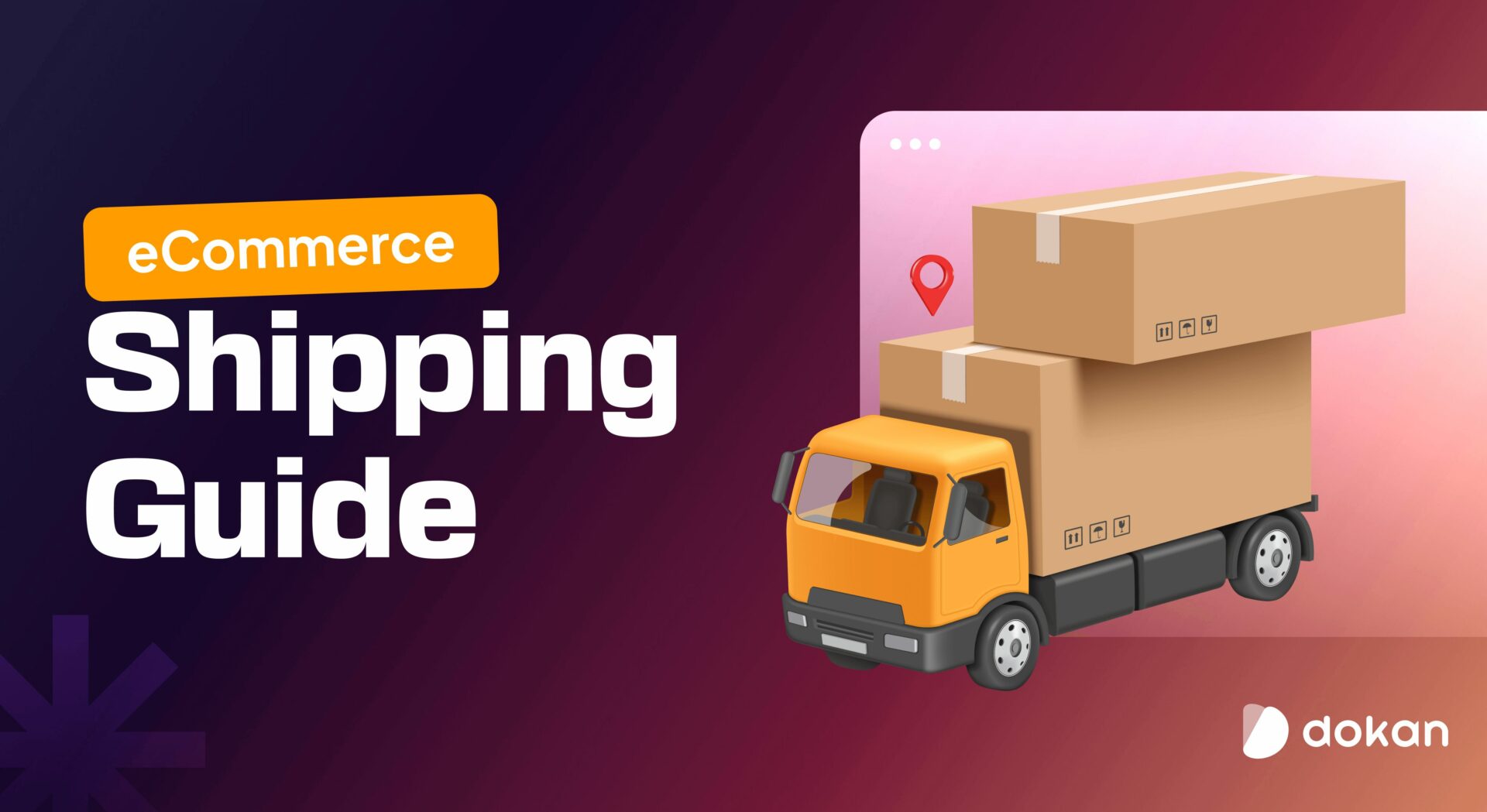
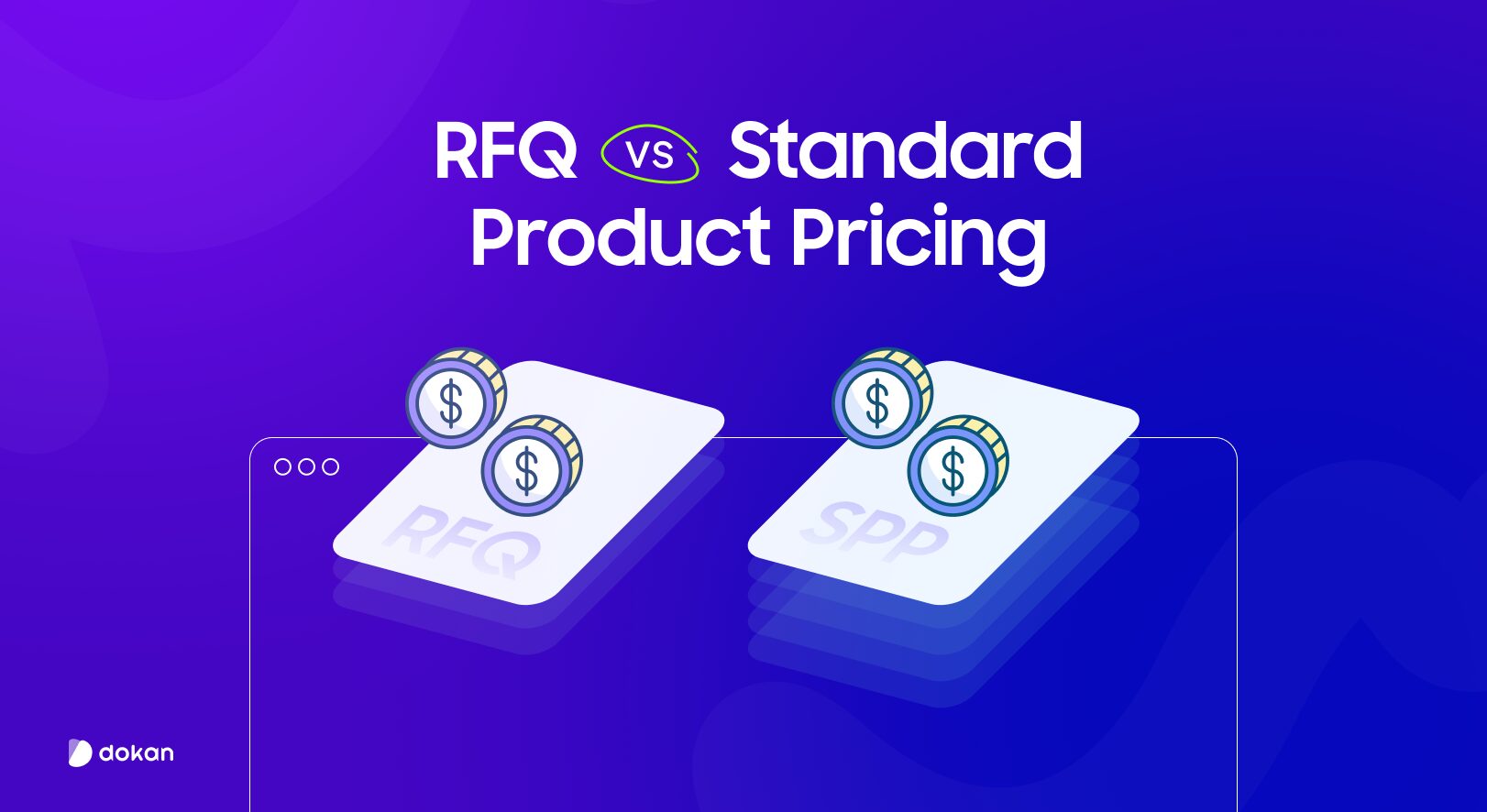


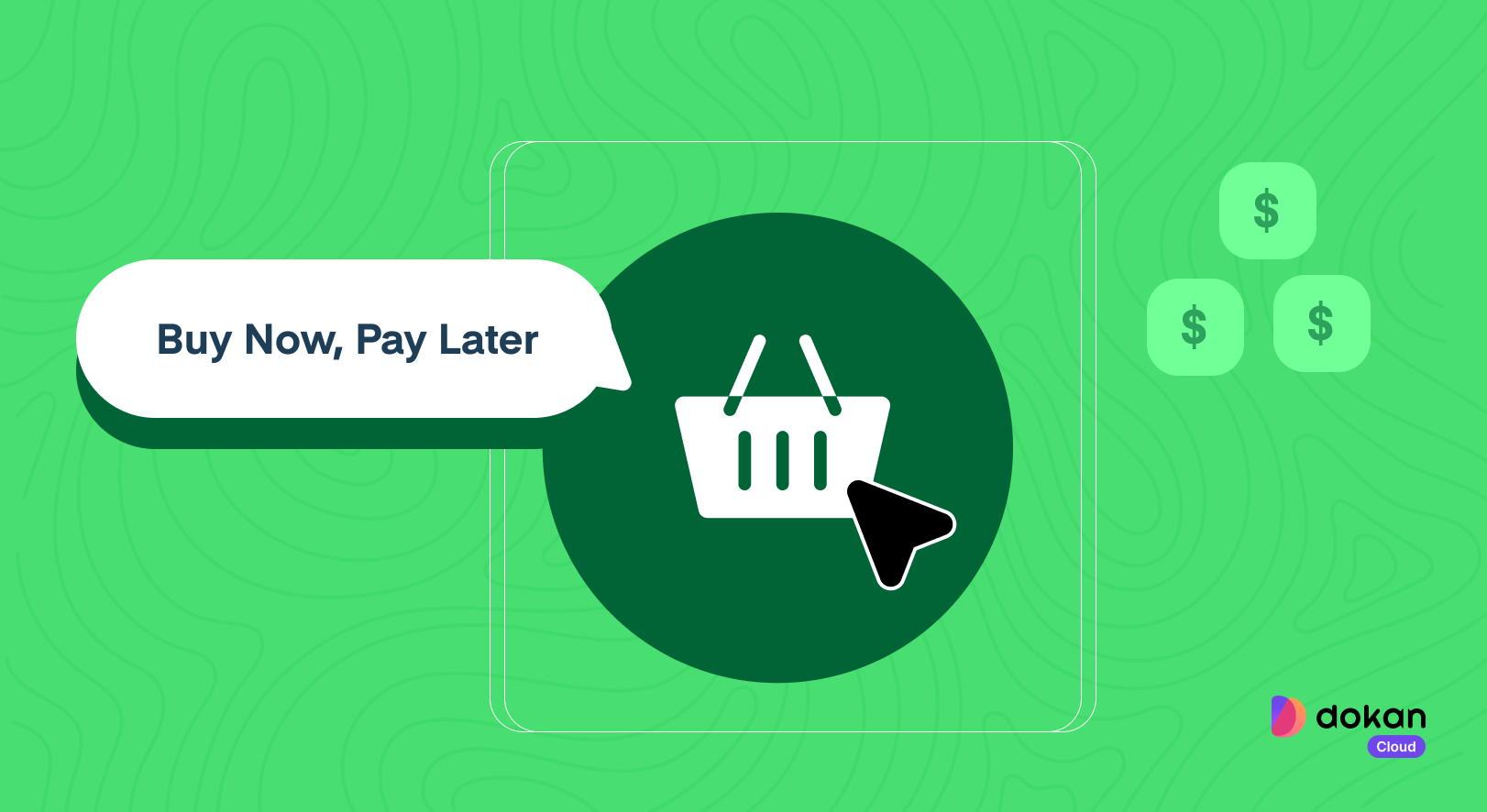

Leave a Reply